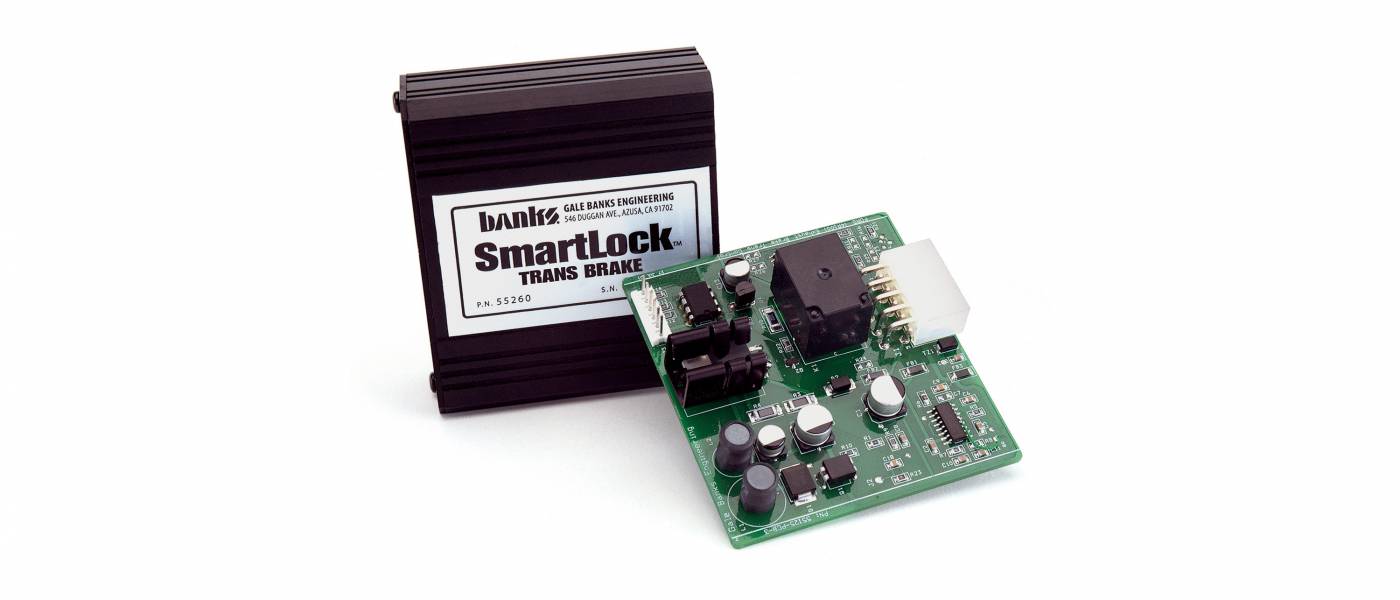The Banks SmartLock
To get maximum performance from a Banks Brake on a ’94-03 Ford 7.3L Power Stroke turbo-diesel or a ’92-03 Dodge/Cummins 5.9L turbo-diesel with an automatic transmission, the SmartLock is a must.
| — Banks SmartLock Trans Brake —
Highly recommended for heavy loads • Easy to install • No calibration required |
Regardless of what you call it, a diesel engine exhaust brake, diesel exhaust backpressure brake, turbo brake, a pickup or RV jake brake, or simply an exhaust brake, such a supplemental brake is a great investment for diesel motorhomes and pickups that are used to haul heavy loads, pull trailers, or are used in hilly or mountainous country. That includes just about all diesel pickups and motorhomes. Such a brake not only adds braking safety to the vehicle, it also saves considerable wear on the vehicle’s service brakes. This is because diesel engines provide little or no braking effect when the driver backs off the accelerator pedal (see “How an Exhaust Brake Works” elsewhere on this site).
An exhaust brake creates the diesel exhaust backpressure to generate engine braking. This braking force then needs to be applied to the rear wheels of the vehicle. Unfortunately, Ford and Dodge pickups fitted with automatic transmissions don’t transmit the engine braking force created by an exhaust brake to the rear wheels. These vehicles were not designed with an exhaust brake in mind, so when the driver releases the accelerator pedal, the on-board engine computer signals the electronically-controlled automatic transmission to supply minimum transmission hydraulic line pressure to the clutch packs and to unlock the torque converter clutch. The torque converter essentially “free wheels” and very little braking load is transmitted to the clutch packs and transmission output shaft. These features were programmed into the Ford and Dodge automatics through the ’02 model year to enhance fuel economy and to reduce the pressure against the transmission seals when no load was anticipated. Banks solved the problem by engineering the SmartLock to solve these problems for Ford and Dodge automatics.
The SmartLock is a microprocessor-controlled device that monitors operation of the exhaust brake, engine RPM, vehicle speed, and the electronic engine control (EEC) processor. It also interfaces with the transmission’s electronic pressure valve (EPV) and the torque converter lockup solenoid. During engine braking created by the exhaust brake, the SmartLock locks the torque converter at engine speeds above 1200 RPM, and computes the appropriate transmission line pressure required to prevent the clutch packs from slipping under the braking load being generated. It does this by matching the line pressure to the factory value necessary to prevent slippage under an identical acceleration load. By not increasing line pressure above the amount necessary, transmission pump and seal life is enhanced.
The SmartLock disengages the torque converter clutch below 1200 RPM to prevent lugging down the engine. The Banks Brake exhaust brake also releases below 15 MPH to eliminate any exhaust restriction noise and to allow faster throttle/turbocharger response when the accelerator pedal is next depressed.
The SmartLock is an electronic transmission management computer that overlays the vehicle’s electronic engine control processor. Those of you who have read “Why Add a TransCommand” elsewhere on this site may be wondering if the SmartLock is the same thing. No, the TransCommand is designed to increase automatic transmission line pressure for firmer shifts and reduced clutch pack slippage during acceleration. It works as a “stand alone” transmission enhancement, or in conjunction with a Banks power system. The SmartLock, by comparison, is designed to increase transmission line pressure and lock the torque converter during deceleration in conjunction with an exhaust brake. And yes, the TransCommand and the SmartLock are compatible and both may be used on the same vehicle. This is because the SmartLock functions only when the accelerator pedal is fully released, or in the idle position, whereas the TransCommand has virtually no affect on transmission line pressure in the idle position.
Only the ’01-03 Chevy/GM 6.6L DuraMax offers the DuraMax tow/haul mode switch on its automatic to allow the driver to keep the torque converter locked at speeds above approximately 20 MPH, and the transmission line pressure up to keep the clutch packs from slipping. This permits some engine braking from engine friction – or the installation of an exhaust brake. Consequently, Duramax pickups don’t need the SmartLock.
Installation of the SmartLock is easy. The fully potted microprocessor in its extruded aluminum case is mounted out of sight under the vehicle’s dash. The SmartLock wiring harness is then plugged into the unit and the EEC. Ford vehicles require extra connections directly to the Ford transmission. Factory-style connectors are provided to simplify the connection.
Not only does the SmartLock improve the performance of a Banks exhaust brake, it also extends transmission life by eliminating the fluid heating that otherwise occurs when the torque converter free-wheels and the clutch packs slip. The SmartLock is highly recommended to get the most out of an exhaust brake whenever one is installed on a Ford 7.3L Power Stroke or a Dodge/Cummins 5.9L turbo-diesel with an automatic.
For more information on the SmartLock, see “Banks SmartLock Trans Brake” in Braking Systems.

